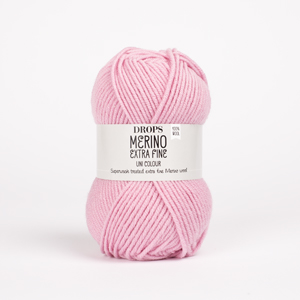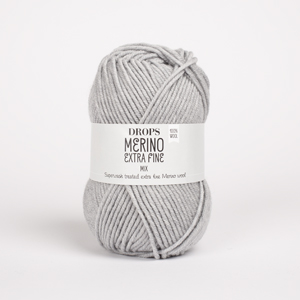Komentáře / Otázky (21)
![]() Shauna napsala:
Shauna napsala:
I don’t have a printer so I am working off my IPad whilst knitting this pattern. Not having the rows numbered on the pattern chart makes it a bit difficult. As a suggestion it would be so helpful if you could update the chart and add numbers please. It’s a beautiful design and thank you for supplying it free!
17.04.2025 - 08:39
![]() Constance Dellinger-Brooks napsala:
Constance Dellinger-Brooks napsala:
I sure wish I could get a printed pattern for this hat. Having to scroll, write it down, scroll a little more, keep writing is so difficult for this 80 year old knitter! I love the pattern & plan to make a dozen for my “great” grandchildren. Thanks.
22.12.2024 - 19:25Odpověď DROPS Design :
Dear Constance, you can print this pattern easily; just click on the print button, next to the pattern's name and select your printer. Happy knitting!
22.12.2024 - 22:49
![]() Nicole napsala:
Nicole napsala:
Merci pour ce beau patron! Drops Design, meilleur site tricot pour moi!
15.12.2024 - 21:46
![]() Sylvie napsala:
Sylvie napsala:
Bonjour, J'aimerais savoir si la taille 12 ans pourrait convenir à un adulte, ou peut-on ajouter une séquence de mouton pour obtenir une taille adulte? merci à vous
01.12.2024 - 13:43Odpověď DROPS Design :
Bonjour Sylvie, retrouvez ce modèle en taille adulte ici, à partir du S. Le schéma des mesures pourra vous aider à adapter les explications si besoin entre la taille 12 ans de ce modèle et la taille S de la version adulte. Bon tricot!
02.12.2024 - 09:58
![]() Lise Leclerc napsala:
Lise Leclerc napsala:
Which store distributes DROPS MERINO EXTRA FINE wool from Garnstudio (belongs to yarn group B)for Canada ? When I order online for Canada, I am redirected to an online store in the U.K. Same thing if I order from Ontario, Canada. Will I have to pay customs fees not mentioned or estimated at the time of purchase?
18.08.2024 - 21:32Odpověď DROPS Design :
Dear Lise, here you have the stores that sell or ship to Canada: https://www.garnstudio.com/findastore.php?id=15&cid=19. You should ask the stores directly for any possible fees when making a purchase from Canada. Happy knitting!
18.08.2024 - 22:38
![]() Kathleen napsala:
Kathleen napsala:
I love this hat & your colour-way but wondering if you have pics of other colour ways?
11.05.2024 - 11:29Odpověď DROPS Design :
Dear Kathleen, there is an adult sweater in another colorway, you can see that if you rool down to the bottom of the page. I hope this helps. Happy Knitting!
12.05.2024 - 01:46
![]() Pamela napsala:
Pamela napsala:
I'd love these patterns. They are beautiful
16.03.2024 - 15:44
![]() Lilianne napsala:
Lilianne napsala:
Hello everyone I am speculating making this hat in Adult size and I thought ,I will just look for a hat that’s looks the same with the same gauge and voila there you have it and check how many Stiches you need to repeat the pattern in this case 8 and the rest you have to do the math.
15.11.2023 - 03:33
![]() Daniela napsala:
Daniela napsala:
Bellissimi modelli e istruzioni chiare, grazie. È possibile trasformare il modello per ferri dritti?
07.09.2021 - 12:37Odpověď DROPS Design :
Buonasera Daniela, questo modello è stato progettato per la lavorazione in tondo, e non ci è possibile riprogettarlo in questa sede. Buon lavoro!
07.09.2021 - 23:59
![]() Corinne Lloyd napsala:
Corinne Lloyd napsala:
I note that you have a guide to calculate how to enlarge the jumper to man size. Do you have guidance on how to increase the hat size for an adult please? Thank you.
17.07.2021 - 18:01Odpověď DROPS Design :
Dear Corinne, unlike the sweater, unfortunately we do not have a grown up version of this hat. Happy Crafting!
17.07.2021 - 23:01
Lamb Dance Hat#lambdancehat |
||||||||||||||||
 |
 |
|||||||||||||||
Dětská čepice kulich s norským vzorem s ovečkami a bambulí pletená z příze DROPS Merino Extra Fine nebo DROPS Lima. Velikost 3-12 let
DROPS Children 34-2 |
||||||||||||||||
|
---------------------------------------------------------- VYSVĚTLIVKY: ---------------------------------------------------------- VZOR: Viz schéma A.1. Zobrazeny jsou všechny řady vzoru nahlížené z lícové strany. TIP - UJÍMÁNÍ: Abychom vypočítali, v jakých rozestupech musíme ujímat, vydělíme celkový počet ok v řadě (např. 112 ok) počtem ok, která potřebujeme ujmout (tj. 8), takže 112 : 8 = 14. V tomto případě tedy spleteme dohromady každé 13. a 14. oko. ---------------------------------------------------------- POPIS PRÁCE: ------------------------------------------------------- ČEPICE - JAK BUDEME POSTUPOVAT: Pleteme v kruhových řadách na krátké kruhové jehlici, s ubývajícím počtem ok převedeme pleteninu na ponožkové jehlice. ČEPICE: Na krátkou kruhovou jehlici č.2,5 nahodíme pistáciovou přízí 112-112-120-128-128 ok a upleteme 1 kruhovou řadu hladce. Pak pleteme lem pružným vzorem 2/2, tj. střídáme 2 oka hladce, 2 obrace – začínáme 2 oky obrace. Ve výši 3 cm převedeme pleteninu na kruhovou jehlici č.3. Upleteme 1 kruhovou řadu hladce a SOUČASNĚ ujmeme rovnoměrně 8 ok (platí pro všechny velikosti) - viz TIP - UJÍMÁNÍ = 104-104-112-120-120 ok. V následující kruhové řadě začneme plést vzor A.1 (= 13-13-14-15-15 sekvencí vzoru po 8 okách). Po dokončení 1 celé sekvence vzoru A.1 (na výšku) dokončíme díl světlou šedomodrou přízí. Ve výši 15-15,5-16,5-17,5-18,5 cm vložíme mezi každé 2 sekvence vzoru A.1 značku = 13-13-14-15-15 značek (tj. značky jsou rozmístěné vždy po 8 okách). Teď začneme tvarovat vrcholek čepice – ujímáme v každé 2. kruhové řadě, takto: Za každou značkou ujmeme 1 oko, ujímáme přetažením, tj. 1. oko sejmeme hladce, 1 oko upleteme hladce a sejmuté přes ně přetáhneme (= v kruhové řadě ujmeme 13-13-14-15-15 ok). Pak upleteme 1 kruhovou řadu bez ujímání. Tyto 2 kruhové řady opakujeme až do chvíle, kdy nám na jehlicích zůstane posledních 13-13-14-15-15 ok. Upleteme 1-1-0-1-1 oko hladce, pak spleteme každá 2 oka hladce = 7-7-7-8-8 ok. Přízi odstřihneme, protáhneme zbylými oky, stáhneme a zapošijeme. Čepice měří asi 19-20-21-22-23 cm. BAMBULE: Ze světlé šedomodré příze vyrobíme bambuli o průměru asi 5 cm a přišijeme ji na vrcholek čepice. |
||||||||||||||||
Vysvětlivky ke schématu |
||||||||||||||||
|
||||||||||||||||

|
||||||||||||||||
Dokončili jste tento model?Pak označte své fotky tagem #dropspattern #lambdancehat nebo je pošlete do galerie #dropsfan. Potřebujete s tímto návodem poradit?Otevřete-li si návod na stránce garnstudio.com, najdete tam 17 výukových video-ukázek, Komentáře/Dotazy a další užitečné informace. © 1982-2025 DROPS Design A/S. Vyhrazujeme si veškerá práva. Tento dokument, včetně všech jeho dílčích částí, podléhá autorským právům. Podrobnější komentář k možnostem užití našich návodů najdete dole pod každým návodem na našich stránkách. |
||||||||||||||||



























































Přidejte komentář k návodu DROPS Children 34-2
Rádi bychom věděli, co si o tomto modelu myslíte!
Pokud se chcete na něco zeptat, dbejte prosím na to, abyste ve formuláři níže vybrali správnou kategorii - díky tomu se dříve dozvíte, co potřebujete vědět. Povinná pole jsou označena *.